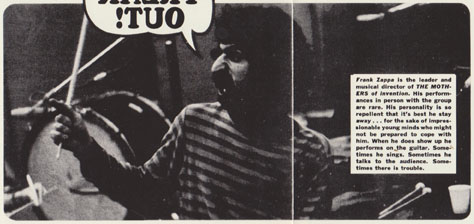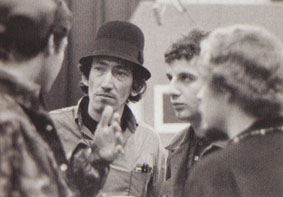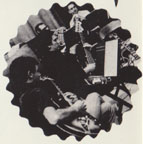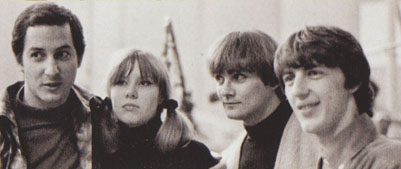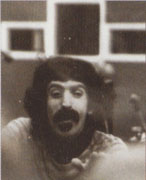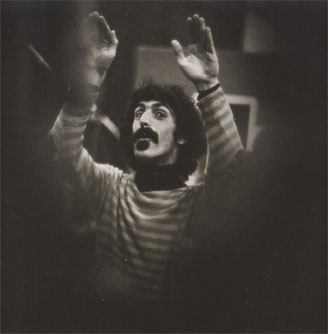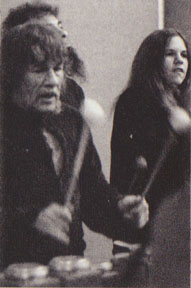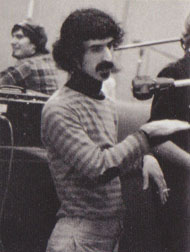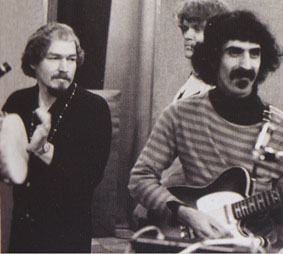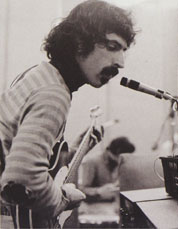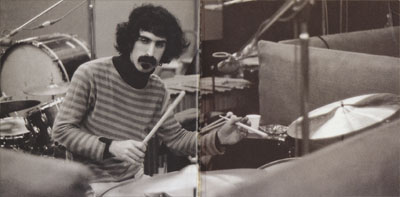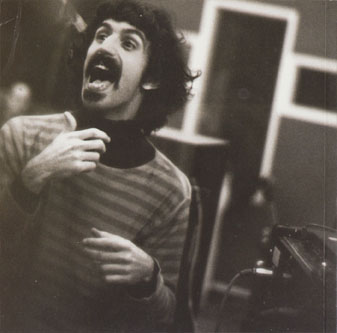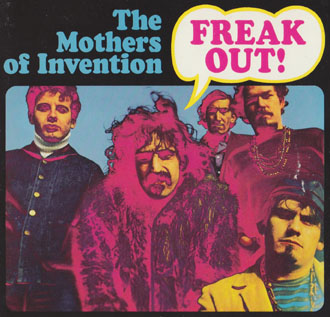The Different Releases
Main Versions
For more details, see Freak Out!, Vinyl-vs-CDs FAQ, The Zappa Patio and 001 Freak Out, The Official Releases, Zappateers.
- 1966 Stereo Mix
- (2LP, Verve/MGM, V6-5005-2, 1966)
- (UK, 2LP, Verve/MGM/Polydor, 2683004, 1971)
- (2LP, Barking Pumpkin, BPR 7777-1, 1985)
- (EU, 2LP, Zappa Records/Today Croydon, ZAPPA 1, 1985)
- The MOFO Project/Object (4CD, Zappa Records, ZR 20004, 2006)
- (2LP, Zappa Records/Universal, ZR 3834-1, 2013)
- 1966 Mono Mix
- (2LP, Verve/MGM, V-5005-2, 1966)
- 1967 1 LP Edit
- Stereo Mix
- (UK, 1LP, Verve/MGM/EMI, SVLP 9154, 1967)
- Mono Mix
- (UK, 1LP, Verve/MGM/EMI, VLP 9154, 1967)
- 1980s Digital Stereo Mix
- (CD, Barking Pumpkin/Rykodisc, RCD 40062, 1987)
- (EU, CD, Zappa Records/Today Croydon, CDZAP 1, 1987)
- (CD, Rykodisc, RCD 10501, 1995)
- (CD, Zappa Records/Universal, ZR 3834, 2012)
Length Of Tracks
| Track |
LP, Zappa Records, 1985—on the sleeve |
LP, Zappa Records, 1985—on the label |
CD, Rykodisc, 1995 |
The MOFO Project/Object (2006), CD 1 |
CD, Zappa Records/Universal, 2012 |
| 1. Hungry Freaks, Daddy |
3:27 |
3:27 |
3:29 |
3:32 |
3:30 |
| 2. I Ain't Got No Heart |
2:30 |
2:33 |
2:35 |
2:34 |
2:35 |
| 3. Who Are The Brain Police? |
3:22 |
3:23 |
3:33 |
3:25 |
3:33 |
| 4. Go Cry On Somebody Else's Shoulder |
3:31 |
3:39 |
3:40 |
3:43 |
3:41 |
| 5. Motherly Love |
2:45 |
2:47 |
2:45 |
2:50 |
2:45 |
| 6. How Could I Be Such A Fool |
2:12 |
2:13 |
2:13 |
2:16 |
2:13 |
| 7. Wowie Zowie |
2:45 |
2:51 |
2:53 |
2:55 |
2:53 |
| 8. You Didn't Try To Call Me |
3:17 |
3:19 |
3:18 |
3:21 |
3:18 |
| 9. Any Way The Wind Blows |
2:52 |
2:14 |
2:55 |
2:55 |
2:55 |
| 10. I'm Not Satisfied |
2:37 |
2:30 |
2:38 |
2:41 |
2:38 |
| 11. You're Probably Wondering Why I'm Here |
3:37 |
3:40 |
3:38 |
3:41 |
3:38 |
| 12. Trouble Every Day |
6:16 |
5:50 |
5:50 |
5:53 |
5:50 |
| 13. Help, I'm A Rock |
8:37 |
4:42 |
4:43 |
4:42 |
4:43 |
| 14. It Can't Happen Here |
3:56 |
3:56 |
3:59 |
3:56 |
| 15. The Return Of The Son Of Monster Magnet |
12:17 |
12:20 |
12:17 |
12:22 |
12:19 |
The 2013 Vinyl
We used a digital source for the new Freak Out! 2013 vinyl reissue. [...] Back in 2005-6 during production of MOFO, I transferred the original master tape of FO to digital and made an analog tape backup at the same time. When comparing my 2006 transfer against FZ's transfer made in '87 to Sony 3324, the Sony transfer sounded better. It's true, tape does not improve over time, especially if it's been stored badly (which we all know is the case with a bunch of Frank's masters from the 60's). The Freak Out master is on acetate tape, which means it's not heat treatable. It is what it is. It's also fragile, acetate tape tends to warp over time and many plays. The tape pack can be less then ideal in the end. So, with this in mind, the decision to use the 1987 digital transfer makes sense.
[...] In fact, the Old Masters version is most likely the last time the original 1966 mix was offered officially. It seems the master tape was used multiple times during the 80's.
March, 1966—Freak Out! Recording Sessions
The first two albums were done four track.
The Musicians
03/09/66 (2-6PM) T.T.G. Studios—Any Way The Wind Blows; Hungry Freaks, Daddy;
Who Are The Brain Police?; You're Probably Wondering Why I'm Here (this is the
exact order of their first recordings)
MUSICIANS: FZ (leader, arranger and copyist), Elliot Ingber, Roy Estrada, Jimmy
Black, Eugene DiNovi (piano), Gene Estes (2 doubles—not specified), Neil Levang,
Benjamin Barrett, Raymond Collins
03/09/66 (7-10:30PM) T.T.G. Studios—Go Cry On Somebody Else's Shoulder; Wowie
Zowie; Trouble Comin' Every Day; Motherly Love
MUSICIANS: FZ (leader, arranger and copyist), Elliot Ingber, Roy Estrada, Jimmy
Black, Eugene DiNovi (piano), Gene Estes (2 doubles—not specified), Neil Levang,
Benjamin Barrett
03/10/66 (2-6PM) T.T.G. Studios—I'm Not Satisfied; You Didn't Try To Call
Me; I Ain't Got No Heart; How Could I Be Such A Fool
MUSICIANS: FZ (leader, arranger and copyist), Johnny Rotella (3 doubles—not
specified), Elliot Ingber, Roy Estrada, Jimmy Black, Kurt Reher, Raymond Kelley (cello),
Paul Bergstrom (cello), Emmet Sergeant (cello), Joseph Saxon (cello), Edwin V. Beach (cello), Arthur Maebe,
George Price, John Johnson, Carol Kaye, Virgil Evans (trumpet), David Wells (trombone), Kenneth Watson, Gene Estes, Eugene DiNovi, Plas Johnson (flute), Benjamin Barrett, Roy Caton (copyist)
03/11/66 (2-5PM) T.T.G. Studios—Any Way The Wind Blows; You Didn't Try To
Call Me; I Ain't Got No Heart; How Could I Be Such A Fool (shown as a "sweetening
session" aka overdubbing session)
MUSICIANS: FZ, Elliot Ingber, Roy Estrada, Jimmy Black, Gene Estes, Benjamin
Barrett
03/12/66 (2-5AM) T.T.G. Studios—Help, I'm A Rock; Brown Shoes Don't Make
It; Return Of The Son Of Monster Magnet; One For Parker Army; Since Cisos
MUSICIANS: FZ (leader, arranger and copyist), Elliot Ingber, Roy Estrada, Jimmy
Black, Gene Estes (1 double—not specified), Benjamin Barrett
Session Sheets vs. Album Credits
TTG Studios
Liner notes by FZ, 1966
WITH SPECIAL APPRECIATION TO AMI [HADANI] & TOM [HIDLEY], THE WORLD'S MOST PATIENT ENGINEERS, AND TO THE SUNSET-HIGHLAND STUDIOS OF T.T.G. Inc.
[...] Director of Engineering: Val Valentin
Freak Out! was made on four-track at T.T.G. Studios, located on Highland Avenue, just off Sunset. Then one of the busiest, independent facilities in Los Angeles, it was opened in 1965 by owner-engineer Ami Hadani, a veteran of the Israeli army who received "special appreciation" from Zappa in the Freak Out! credits.
TTG Studios, which stood for "Two Terrible Guys" (laughs). They weren't terrible guys. It was Ami Hadani and Tom Hidley, the same guys who designed and built all the famous Record Plant studios. Anything but two terrible guys. The cool thing about Ami was that he was a General in the Israeli Air Force, and he'd be doing a session and there'd be problems and he'd have to leave the session and go fly off to Israel, fight the war, then come back and finish a session. Weeks could go by, it was kind of funny.
Tom Hidley and Ami Hadani (The "Two Terrible Guys" of TTG) had previously worked for A&R Studios in New York before opening TTG in 1965.
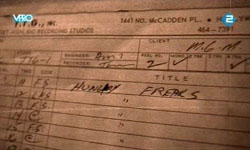
Engineer: Ami
Recorder: Tom
For one of the session dates, Frank had a podium set up in the middle of TTG studios. He showed up wearing a red and yellow striped shirt, an iron cross, and a swallow-tailed conductor's coat with a baton inside. At the proper moment he whipped out the baton and rapped on the podium for silence. One of the cello players hired from the L.A. Philharmonic was heard over the microphone: "Hey, we're really going to have to play. This beatnik has written some music here." "Frank gave it the full Toscanini and conducted their asses off," [Tom] Wilson relates with a smile.
Paul Verna, "From Auto Sound to Infrasound, Hidley's Career Has Been Built On Breakthroughs," Billboard, July 1, 1995
Born in Los Angeles May 27, 1931, [Tom] Hidley began his illustrious musical career when he took up the saxophone at age 11. [...] After seven years of incessant playing, however, he suffered a physical breakdown that forced him to give up playing horn.
[...] Consequently, he turned to nonperforming musical activities, working at tape-machine and loudspeaker companies by day and recording L.A. club gigs by night. In 1956, he landed at the JBL Loudspeaker Co., where his responsibilities included sonic evaluation of speaker performance and audio/video field engineering on custom installations.
[...] During his tenure at JBL, Hidley supervised audio/video installations in the homes of such entertainment giants as Frank Sinatra, Ella Fitzgerald, Lucille Ball, and Danny Kaye.
In 1959, Hidley joined Earl Muntz's Stereo Company, which developed the first known car stereo—a 110-volt, 8-track system that was later modified to run on the car's battery power to avoid the risk of electrocution. Among the first to own the Muntz car stereos, naturally, were the superstars of the day: Spike Jones, Les Brown, Nelson Riddle, Sinatra, and others. In fact, it was Hidley's involvement with Sinatra that led him to Val Valentin, a Sinatra associate who was responsible for building MGM/Verve's recording studios in New York.
"Val said to me, 'Listen, you need to come with me and build my studios,'" Hidley says. "And I said, 'I don't know anything about studios.' He said, 'You'll do it in a minute. No problem.'" So Hidley climbed into his Muntz-customized 1962 Lincoln Continental and headed east.
[...] Within six months, the MGM/Verve facility was built and operational. Hidley continued technically maintaining the equipment and began mixing work for the MGM/Verve staff producers.
By 1964, after two years of 16-hour workdays at MGM/Verve, things began changing again. [...] [Phil] Ramone took notice of Hidley's talents and hired him as audio technical manager of the storied A&R Studios, then a four-room facility comprising a live room, a control room, a disc-cutting room, an all purpose jingle room, and a mix room.
[...] But the brutal New York winter of 1964-65 proved too harsh for Hidley and another A&R alumnus, Ami Hadani, so the two packed up and moved to California to open a studio—this time in a 1965 Lincoln. They found space at the Radio Recorders Annex at Sunset and Highland an began doing business as TTG, which stood for Two Terrible Guys.
The Mothers' Auxiliary
I remember Gene Estes was the principal percussionist and he played the vibes parts.
Neil LeVang
Neil LeVang. Played guitar with [Lawrence] Welk, 1959-1982. Played on Freak Out! (guitar solo on "Any Way The Wind Blows," fuzztone Strat on "Who Are The Brain Police?," and 12-string on "Go Cry On Somebody Else's Shoulder," "Motherly Love," "Wowie Zowie," and "You're Probably Wondering Why I'm Here").
I was called to TTG studios to do an album
with Frank Zappa when he was just starting out. I was working with Welk at the time, and we got through the first session, when Zappa looks at
me, his hands wheelin', and says, "How do you play that way? You're 'Mr.
Straight Life!'" I thought he was out of his mind!
Carol Kaye
Carol Kaye, quoted by Michael Gula, a.f.f-z, August 17, 1999
Frank Zappa had his own bass player and drummer but the rest were studio musicians: Tommy Tedesco on lead guitar on Zappas recordings, Dennis Budimer and myself on 12-strings, and we loved his parts, there were challenging and good music. But after seeing the lyrics of the 2nd album, I opted out (just played on part of the 2nd, but all of the 1st album) as I was raising my 3 children and was sort of shocked at the lyrics, Frank was gracious, very nice and we remained friends, he understood. Yes, you might say I was a prude, but most of our bunch were (then).
The legendary studio bassist and guitarist Carol Kaye was one of the dozen-plus first-call session musicians that played on parts of Freak Out!, and she remembers being
impressed both by Zappa's manner as he led the musicians and the charts he handed
out at the date. "Frank had training in his writing—you could see that," says Kaye, who
contributed electric twelve-string-guitar fills on four tracks, including "I'm Not Satisfied" and "You Didn't Try to Call Me." "And the stuff was good," Kaye insists. "Frank knew what
he wanted, and we loved that. You had respect for him, because you knew this kid
had something."
[Tom] Wilson was listed as producer on Freak Out!, but he essentially let Zappa run the sessions. [...] "Frank was in charge," Carol Kaye says, without hesitation. "Funny—I don't remember Tom hardly at all at that session, although I worked with him on other records. And that was wise—for the guy behind the
glass to let the artist do his thing."
Kaye also remembers THE MOTHERS as a band. "Sometimes on sessions, the producer would have friends or his particular favorites sitting in. Usually they couldn't play very well, and you had to carry them. These guys played well. We didn't have to give them a kick or anything," she adds, laughing.
Kim Fowley
Liner notes by FZ, 1966
Kim Fowley (Featured on hypophone)
He was just one of those people who was wandering around the
street in Los Angeles in those days. The hypophone is his mouth, 'cause all
that ever comes out of it is hype. I don't listen to much of what he does now. I happen to like "Popsicles & Icicles" by the Murmaids on the Chattahoochee label, I dunno about his recent stuff.
Somehow [FZ] picked up on you to sing on the Freak Out album. Was he aware of your stuff?
No, he didn't know who Kim Fowley was. He knew me because a) Elliot Ingber said I was cool and Elliot Ingber was his original guitar player. Because Elliot knew me from way back when he was in the Gamblers, and he was also in a group called the Phil Harvey Band; they were Phil Spector's instrumental group and they were great. And I knew him from around town and, b) he knew I could get up there and . . . I'm a sensational performer. I'm really astonishing as a performer. I'm a piece of shit as a human being and I'm an asshole as a businessman, and I'm creatively valid, but in front of an audience I'm one of the most entertaining fucking things you've ever seen. [...]
OK, so through Elliot Ingber you hooked up with Zappa and what? He just invited you to appear on the album?
He invited me to jam.
In the studio, you mean?
No. His idea of a jam was "We're doing a gig. Show up on stage and if you're great you can sing with us, and if you're horrible that'll be great too because then I'll tear you apart and throw you in the street and that'll be good too. I don't care either way whether you're good or not." But I happened to be good.
I showed up at the corner of La Cienega and Santa Monica in a redwood kind of shingle place. It was short-lived, not a normal venue. In those days clubs would open and close in a matter of weeks. I don't remember what the name of it was, but I did really good and I remember he said, "You're my Brian Jones!"
I said, "Oh shit!"
Then he told me to come down to the studio—he didn't ask, he told. Then everybody made his record with him and nobody got paid any money, and nobody got paid any royalties either; no session man royalties either, but we all did it anyway. It was a great night.
So it was all basically done in one night; one big freakout, like it said?
Yeah.
Was Zappa directing things very closely, or did he just kind of let the tape roll and let the freaks play?
It was organized chaos. It was like the Titanic on a recording studio floor, like "The ship is sinking. Let's get all these people's agony on tape" kind of a 'happening' type thing. I guess he took the Hindenburg disaster and an Andy Warhol happening and made an album of it. I sang "Help I'm A Rock" on the album and I sang on some other tracks.
What happened after that? Did he want you to continue to perform with the Mothers?
Yeah, he came to my apartment and said, "I want you to be my Brian Jones. I want you to be a permanent member of the band" and I said no.
Why didn't you want to do that?
I said, "I know I'm fun to watch in the context of what you're doing, but I'm not interested in pursuing that as a career."
He said, "What is your career?"
I said, "Fucking dirty bitches and making stupid records, and when all this longhair bullshit is over with I will go back to what I was before the long haired thing. I'll just be a short haired guy in a suit doing business with music. Frank, I've had three #1 records in the world, so I know what it's like to get royalties and fees and stuff, and if I'm your Brian Jones I'm just a weird guy in a weird guy's band and I will end up with no money and no nothing. And although I'll fuck some amazing bitches and have some great times, it won't mean anything and I'd rather stumble along and scream like a dog. I'm my own man."
What I should have done, in hindsight, is done two or three albums with him, and then I would have been legitimate as a performer because I would have had Zappa certification—"Well, he can't be too bad he's on three albums with Frank." But I'm only on one album with Frank. But the great one that you should lobby to find is The Mothers of Invention Live at the Whisky, which was the same people that did the first album all reunited to do the same exact songs in front of a live audience. Somewhere in Frank's archives there's that live album of all of us a year later, in '66, all reunited, every last person that was on that record showed up and did the same shit again.
Uncredited
Bobby Beausoleil
[Bobby Beausoleil] briefly played in a band with Arthur Lee, called Grass Roots. Grass Roots would later achieve fame under the name Love. Lee apparently named the group Love as a reference to Beausoleil's nickname "Cupid". Bobby also became friends with Frank Zappa, and can be heard as a backup singer on Zappa's first record, Freak Out.
Frank Zappa, another guy I made friends with in L.A., was a really interesting guy to me. In fact I was on his first album, just as a guest—the Freak Out album. I was one of the people yelling "Help, I'm a rock! Help, I'm a rock!" "We are the brain police!" and all those things. He just came and got me and a few of my friends off the street and put a microphone in front of us and had us do that. Frank Zappa came to the scene lampooning that sort of superficiality: "Brown Shoes Don't Make It," "Plastic People, You've Got to Go Now". . . that was the L.A. scene.
Terry Gilliam
The MOFO Project/Object (2006) Freak Out! amended liner notes by Gail Zappa
THE MOTHERS' AUXILIARY
[...]
Terry Gilliam!
Participants also include [...] and of course, Terry Gilliam. Who knew(?).
Also there: [...] a young Terry Gilliam, future Monty Python animator and director of Brazil and Twelve Monkeys.
Biographical Trivia
Ray Collins
Liner notes by FZ, 1966
Ray used to be a carpenter and a bartender and sing with Little Julian Herrera & The Tigers (note the falsetto part in "I REMEMBER LINDA")... been singing R & B for ten or twelve years.
One of the things that I didn't like about the album was the fact that he put Julian Herrera's name like in big letters, like it was a major part of my life, or a major part in anybody's life. But my association with The Tigers and Julian Herrera had absolutely nothing to do with Frank Zappa or The Mothers.
[...] Art Laboe paid me ten dollars for the session. [...] The Tigers were friends of mine, or acquaintances, from Pomona, and we were going along as a group. And three of these guys—James Thompson, Ron Ellington Shy, and Prentiss—I forgot his first name—they were recording already and performing with Little Julian, and so I just kind of went along with them to Hollywood, to watch them in session, and I just sort of—Art Laboe, in the studio, said, "Can you do a falsetto," or "Do you want to," or something. So I jumped up and did it right there. [...]
I think Little Julian wasn't too thrilled about it. He was an overpowering, semi-unfriendly person at the time—to me at least, anyway. [...] You know, Art Laboe used to have his live show at Scrivener's Drive-In, and he had us there, talking, and of course I think you must know that Julian Herrera was arrested for statutory rape about the time that "I Remember Linda" started moving up on a local chart level; and it kind of killed the record, really. So we went on without him, The Tigers. As a matter of fact, I ran into Ron Ellington Shy about four nights ago, and he was still angry at Julian after—for that record dying because of what happened.
George Lipsitz, "Introduction—Creating Dangerously: The Blues Life Of Johnny Otis," Upside Your Head! Rhythm And Blues On Central Avenue, 1993, p. xxvi-xxvii
One day a probation officer showed up at [Johnny] Otis's door asking about a "Ron Gregory." Otis didn't know anyone by that name, but when the officer showed him a picture, he recognized L'il Julian. It seems that Herrera was a Hungarian Jew from the East Coast named Ron Gregory, who had run away from home and been taken in by a woman in Boyle Heights who raised him as her son.
Dominic Priore, Riot On Sunset Strip, 2007, p. 54
[Little Julian] Herrera was in fact of Eastern European heritage, and was born on the East Coast. After running away from home at a young age he was adopted by a Mexican-American family before being snapped up by Johnny Otis's Dig Records on the strengeth of his powerful stage presence. The haunting ballad "Lonely Lonely Nights" and "Symbol Of Heaven" (1957) were both huge local hits.
In 1958 deejay Art Laboe signed Herrera to his Starla label and found the singer a permanent band. But the ensuing "I Remember Linda," recorded with his group The Tigers and backed by a cover of Little Richard's "True Fine Mama," ended up being Herrera's last release for a while: his career ground to an abrupt halt when he was imprisoned for statutory rape.
Roy Estrada
Roy Estrada And The Rocketeers "Jungle Dreams" (Jack Cortez), King 45-5368, 1960
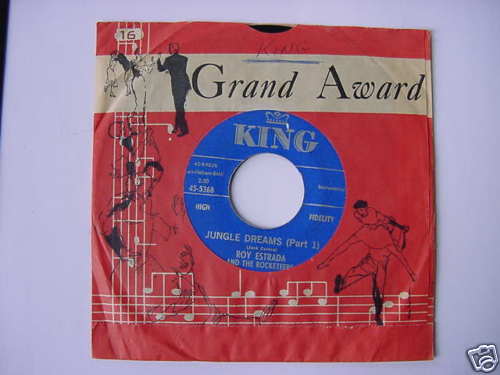
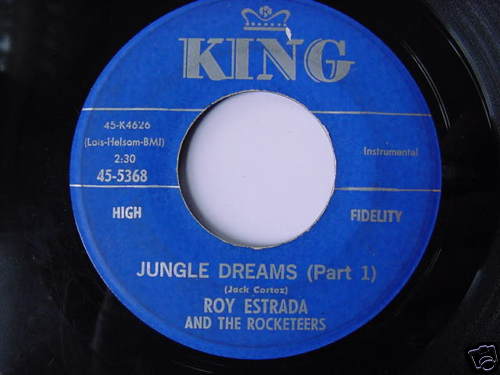
"Relevant Quotes"
Edgard Varèse
Liner notes by FZ, 1966
"The present-day composer refuses to die!"
EDGAR VARESE, July 1921
Edgard Varèse, Manifesto of the International Composers' Guild, 1921, from Felix Meyer (ed.), Edgard Varèse, Composer, Sound Sculptor, Visionary, The Boydell Press, 2006, p. 120
Dying is the privilege of the weary. The present day composers refuse to die. They have realized the necessity of banding together and fighting for the right of each individual to secure a fair and free presentation of his work. It is out of such a collective will that the International Composers' Guild was born.
Plural versus singular.
Now you've got to remember that composers throughout this century have been bonding together into collectives for the purpose of getting their works performed—Varese did it, lots of others did it and I did it too [...]. Other composers collectives exist here in southern California and I know of them in other parts of the world as well. They seem to be useful but not completely successful method of letting a composer survive in a culture that gives no value to music composition.
Frank would never have been able to work in such a situation—he seemed to thrive on being totally alone while he wrote music or edited in the studio or with the Synclavier. Then he would come out of the studio and present his music to the performers. When given a performance opportunity—a commission, for example—he would expand his plans to include all possible resources (often going well beyond the capabilities of the commissioning organization to keep up). There was no room for sharing.
[...] I'm pretty sure that it means that Frank knew instinctively to stay away from the 'new music scene' and away from other composers.
Sidney Finkelstein, Complete Works Of Edgard Varèse Volume 1 (EMS 401, 1950) liner notes
Varése has helped make musical history in other ways than his own music. In France and in Germany he was in the forefront of musical experiment. Living in the United States since 1916, he took a leading part in the first presentation of concerts of twentieth century music, organizing the International Composers Guild in July 1921 and declaring in a manifesto, "the present-day composer refuses to die!"
Laurentine Finance Co.
Liner notes by FZ, 1966
"Tell us where those drums are . . . we want to repossess them . . . we'll call M G M Records! We're a multi-million dollar company and we can play havoc with you"
LAURENTINE FINANCE CO.
March 1966
The idea of some guy sitting there and saying "We're a multi-million dollar operation, and we can raise havoc with you" . . . you know, saying that to Jimmy Carl Black, was just too good to miss.
3. Who Are The Brain Police?
Liner notes by FZ, 1966
At five o'clock in the morning someone kept singing this in my mind and made me write it down. I will admit to being frightened when I finally played it out loud and sang the words.
At the time I was living in a part of town called Echo Park [...] I wrote "Brain Police," "Oh No, I Don't Believe It," "Hungry Freaks," "Bowtie Daddy," and five or six others.
[...] "Brain Police," was a phenomena because I was just sitting in the kitchen at the Bellevue Avenue house and I was working on "Oh No, I Don't Believe It," which didn't have lyrics at the time . . . and I heard, it was just like there was somebody standing over my shoulder telling me those lyrics and it was really weird. I looked around . . . I mean, it wasn't like, "Hey Frank, listen to this . . . " but it was there. So I just wrote it down and figured the proper setting for it.
"Who Are the Brain Police?" (from Freak Out!, 1966)—Fender Stratocaster guitar, Fender Deluxe amp, fuzz-tone.
"That was the second song we recorded for the album. The producer, Tom Wilson, had come to see us at the Whisky-a-Go-Go, saw us playing a blues number and thought, 'Ah, a white blues band, how hip.' He never really bothered to find out what kind of band we really were.
"The first track we cut was 'Anyway the Wind Blows': nice, safe, fine. The second was 'Who Are the Brain Police?' He immediately got on the phone to the record company: 'Uh-oh!'"
Perceived Instrumentation vs. Different Mixes
| |
Left |
Center |
Right |
| Basic tracks (MOFO, CD 2, track 9) |
|
Bass—Roy Estrada
Drums—JCB
Piano—Eugene DiNovi
Timpani, cymbals—Gene Estes
Electric guitar #1—
Electric guitar #2—
|
|
| Basic tracks (1970 remix) (MOFO, CD 4, track 2) |
Electric guitar #1—
Electric guitar #2— |
Bass—Roy Estrada
Drums—JCB |
Piano—Eugene DiNovi
Timpani, cymbals—Gene Estes |
| 1966 mono mix (MOFO fazedooh, CD 2, track 2) |
|
Bass—Roy Estrada
Drums—JCB
Piano—Eugene DiNovi
Timpani, cymbals—Gene Estes
Electric guitar #1—
Electric guitar #2—
Percussion—
Vocal #1—FZ
Vocal #2—Ray Collins
Kazoo—
|
|
| 1966 stereo mix (MOFO; MOFO fazedooh) |
Drums—JCB
Electric guitar #1—
Electric guitar #2— |
Vocal #1—FZ
Vocal #2—Ray Collins
Kazoo— |
Bass—Roy Estrada
Piano—Eugene DiNovi
Timpani, cymbals—Gene Estes
Percussion— |
| 1969 remix (Mothermania) |
Piano—Eugene DiNovi
Timpani, cymbals—Gene Estes
Percussion— |
Bass—Roy Estrada
Vocal #1—FZ
Vocal #2—Ray Collins
Kazoo— |
Drums—JCB
Electric Guitar #1—
Electric Guitar #2— |
| 1985 remix (1985 LP; 1995 CD; MOFO, CD 4, track 15; 2012 CD; Understanding America 2012; Porn Wars Deluxe) |
Drums—JCB
Electric guitar #1—
Electric guitar #2— |
Bass—Roy Estrada
Vocal #1—FZ
Vocal #2—Ray Collins
Kazoo— |
Piano—Eugene DiNovi
Timpani, cymbals—Gene Estes
Percussion— |
The (Probable) Four Tracks
Drums—JCB
Electric guitar #1—
Electric guitar #2— |
Bass—Roy Estrada
|
Piano—Eugene DiNovi
Timpani, cymbals—Gene Estes
Percussion— |
Vocal #1—FZ
Vocal #2—Ray Collins
Kazoo— |
Edits
| Freak Out! (MOFO, CD 1, Track 3) |
"Section A, C, B" (MOFO, CD 4, Track 2) |
Freak Out! (2012 CD) |
"Porn Wars Deluxe" (UA) |
"Help, I'm A Rock" (2012 CD) |
| 0:00-1:22 |
0:08-1:30 |
0:00-0:06 |
|
|
| 0:06-0:26 |
14:45-15:05 |
|
| 0:26-1:03 |
|
|
| 1:03-1:22 |
15:05-15:23 |
|
| 1:22-2:09 |
3:33-4:20 |
1:22-1:27 |
|
2:01-2:07 |
| 1:27-2:08 |
|
|
| 2:09-3:22 |
1:45-2:58 |
2:08-2:45 |
|
|
| 2:45-2:49 |
15:23-15:27 |
|
| 2:49-3:21 |
|
|
| |
2:58-3:10 |
3:21-3:33 |
|
|
4. Go Cry On Somebody Else's Shoulder
Liner notes by FZ, 1966
GO CRY ON SOMEBODY ELSE'S SHOULDER . . . (3:31) is very greasy. You should not listen to it. You should wear it on your hair.
I think I was thinking about my ex-wife, if I remember right. So Frank and I were in Cucamonga, and so I said, "Oh, I got this idea about, 'Don't bother me,' 'Go away,' 'Go cry on somebody else's shoulder.'" He said, "Great!" So I sat down at the piano and started playing it, and Frank joined in, and we created "Go Cry On Somebody Else's Shoulder." And then of course, the spoken part that's on the Mothers' album, is all just ad-libbed, right in the studio, about the khakis, and the Mexican input.
I gave you my high school ring
A heavy, gold ring tapering out to a large oval front typically engraved with the school name and your graduating class year, and set with a glass "stone" in the school's colors. (Crawford High School's colors were red, white and blue; the rings came in your choice of those colors. I got a blue one.) You can give it to your girlfriend to "mark your territory." She will wear it on a little chain around her neck.
That's why I had to get my khakis pressed
Since he says "get" them pressed, he probably means send them to a laundry to be professionally flattened in a trouser press. If he just wanted them ironed he'd give 'em to his mom. (He has to still live with his mom, right?)
I got my hair processed
A "process" means straightening naturally kinky African-American hair, usually resulting in a very artifical, lacquered look. With the emergence of black power this became a symbol of oppression. Hence the emergence of the Afro hairstyle. (Except at least in my school they were never called Afros or 'fros . . . they were called "naturals.")
Perceived Instrumentation vs. Different Mixes
| |
Left |
Center |
Right |
| Basic tracks (MOFO, CD 2, track 12) |
|
Bass—Roy Estrada
Drums—JCB
Electric guitar #1—
Electric guitar #2—
Electric guitar #3—
Piano—Eugene DiNovi
Tuned Percussion?—Gene Estes |
|
| Vocal overdub take 2 (MOFO, CD 2, track 3; MOFO fazedooh, CD 2, track 7) |
|
Bass—Roy Estrada
Drums—JCB
Electric guitar #1—
Electric guitar #2—
Electric guitar #3—
Piano—Eugene DiNovi
Tuned Percussion—Gene Estes
Lead vocal #1 (alternate take)—FZ
Lead vocal #2 (alternate take)—Ray Collins |
|
| 1966 stereo mix (MOFO; MOFO fazedooh) |
Bass—Roy Estrada
Drums—JCB
Electric guitar #1—
Electric guitar #2—
|
Lead vocal #1—FZ
Lead vocal #2—Ray Collins
Falsetto #1—Ray Collins
Falsetto #2—Roy Estrada
Bass vocal—FZ |
Piano—Eugene DiNovi
Tuned Percussion—Gene Estes
|
| 1985/1987 remix (1985 LP; 1995 CD; 2012 CD) |
|
Bass—Roy Estrada
Drums—JCB
Electric guitar #1—
Electric guitar #2—
Lead vocal #1—FZ
Lead vocal #2—Ray Collins
|
Piano—Eugene DiNovi
Tuned Percussion—Gene Estes
Falsetto #1—Ray Collins
Falsetto #2—Roy Estrada
Bass vocal—FZ |
The (Probable) Four Tracks
Bass—Roy Estrada
Drums—JCB
Electric guitar #1—
Electric guitar #2—
|
Piano—Eugene DiNovi
Tuned Percussion—Gene Estes
|
Lead vocal #1—FZ
Lead vocal #2—Ray Collins
|
Falsetto #1—Ray Collins
Falsetto #2—Roy Estrada
Bass vocal—FZ |
12. Trouble Every Day
Liner notes by FZ, 1966
TROUBLE EVERY DAY . . . (6:16) is how I feel about racial unrest in general and the Watts situation in particular. It was written during the Watts riot as it developed. I shopped it briefly all over Hollywood but no one would touch it . . . everybody worries so much about not getting any air play. My, my.
Well, the song that we have on the Freak Out! album about the Watts riot was written during the riot. And I was offended by the fact that the riot occurred not so much as the race problem itself but by the fact that both sides appeared to be really stupid, you know. It gets pretty gross if you have to burn down your own house as a protest for some sort of uh, socioeconomic condition.
It's possible that that is the only answer, but uh, I think with some little constructive thinking you might be able to find other ways to solve racial problems.
When Freak Out! came out, Frank received a visit from the FBI. They wanted to know just how involved he had been in the riots.
I wish there was a recording of "Trouble" the way we used to do it when we had Henry Vestine with us. It sounded like a John Lee Hooker song. Man! It was so bluesy! Frank was singing on it and Ray was playing harmonica. Ray didn't want to learn all those words. It was way too many words for him to learn! Since Frank wrote the words, he already knew them and so that was the first song Frank really featured as a vocalist.
Well I'm about to get sick
FZ definitely is singing "sick." What sounds like an extra syllable before the word "sick" is actually one of the double-tracked vocals going out of sync with the other, so you hear the word "get" twice.
They'll send some joker with a brownie
And you'll see it all complete
Well, it's a famous trade name of the line of amateure cameras that Eastman Kodak Co, produced after inventing of a roll of film. The first was "Brownie Box" in 1900 and the last it seems "Brownie II" still on the market in 1986!
There ain't no Great Society
As it applies to you and me
Blow your harmonica, son!
Perceived Instrumentation vs. Different Mixes
| |
Left |
Center |
Right |
| Basic tracks (MOFO, CD 2, track 15; MOFO fazedooh, CD 2, track 1) |
|
Bass—Roy Estrada
Drums—JCB
Electric guitar #1—FZ
Electric guitar #2—
Electric guitar #3—
Lead vocal—FZ |
|
| 1966 stereo mix (MOFO; MOFO fazedooh); 1985/1987 remix (1985 LP; 1995 CD; 2012 CD; Understanding America) |
Drums—JCB
Electric guitar #3— |
Electric guitar #1—FZ
Electric guitar #2—
Lead vocal—FZ
Doubled vocal—FZ |
Bass—Roy Estrada
Electric guitar #4—
Harmonica—Ray Collins |
Edits
| Basic Tracks (MOFO, CD 2, Track 15) |
Freak Out! (2012 CD) |
single (MOFO, CD 4, Track 5) |
Understanding America (2012) |
| |
|
0:00-0:00 |
|
| 0:00-5:49 |
0:00-0:01 |
0:00-0:01 |
0:00-5:07 |
| 0:01-0:09 |
|
| 0:09-1:34 |
0:01-1:27 |
| 1:34-4:18 |
|
| 4:18-5:07 |
1:27-2:33 |
| 5:07-5:23 |
|
| 5:23-5:49 |
|
|
| 5:49-7:06 |
|
|
|
13. Help, I'm A Rock
Original LP label, 1966
2. HELP, I'M A ROCK (Suite In Three Movements)
1st Movement: Okay To Tap Dance
2nd Movement: In Memoriam, Edgar Varese
3rd Movement: It Can't Happen Here
Charles Ulrich, April 30, 2015
There are visible bands on the [Verve LP] for each movement. And the [second] band is indeed at 2:01.
The sessions for Freak Out were extremely well-organized. For "Help I'm A Rock," the people were briefed before the sessions. Frank had the whole date written out on a roll of brown wrapping paper and checked everything off.
In 1966 Tom Wilson produced the Mothers of Invention debut album and I was on it. I sang on 'Help I'm A Rock.' I'm also on the unreleased live Mothers of Invention album from the Whisky A Go Go.
I'm with Frank one day and he's visiting a young girl right there at La
Brea at the top of La Brea where Franklin turns into La Brea and she's living
in apartment there. He says "come on, let's go in this place, there's a
hot chick in there." He must go into the bedroom with her—some kind of
a sex thing or whatever they were doing and I'm standing there waiting for them
in the vestibule of her house and she has like, a rock thing. I always carry
felt pens with me so when they come out I said to the girl "I'm giving
you a present." I give her this present, a rock, and on the back of it
says "Help, I'm A Rock". It's a rock I wrote on and Frank made it
into a song.
There was a school teacher that I knew named Phyllis Rubino, and she had a object in her house that was a rock, and it was painted blue, and written on it there was a sign that said, "Help, I'm a rock." And I thought, "Now, there's a nice name for a song."
Liner notes by FZ, 1966
HELP, I'M A ROCK . . . (8:37) is dedicated to Elvis Presley.
Elliot [Ingber] was starting to grow a beard again when [the cover] photo was taken. He had grown a beard when he joined the band but had to shave it off when he got a job as an extra in the Elvis Presley movie Girls Girls Girls. Elliot got to meet Elvis and told him he was in a band called the Mothers. When Elvis heard "Help, I'm A Rock," he thought it was the craziest thing so he started calling Elliot "Help I'm A Blimp."
Zappa: The reason it was dedicated to Elvis Presley is [...] I am thinking that he had been in to see us but at the time we were playing at The Trip, messages had been conveyed to him about some weird dupe that was working down there playing a song called "Help I'm A Rock" and at that time the guy covered with the dimple, Elliot [Ingber], was an extra in an Elvis Presley movie. When Elvis found out that he was in the group he came up and was rapping to him about our operation, so we dedicated it to him. Through the grapevine we tried to get a message to Elvis Presley to ask whether or not he would be interested in taking a job with us as a road manager. (laugh) I thought it would be the ultimate weirdness to go out on stage in the mid-west someplace and have some guy unannounced who sort of looks like Elvis Presley setting up your amplifier for you. I would just have him do one tour just for fun because he must be bored beyond belief up there in his pad, what an awful life.
John: Yeah and he really isn't utilizing all that talent he has either.
Zappa: In the middle of the show he could sort of just walk on and sing "Hound Dog" and then disappear.
John: Did he do anything that you really liked?
Zappa: "Let's Play House."
Heh, it always looks to me that this song is pervert reference to Simon and Garfunkel 1965 ditty I'm A Rock.
Charles Ulrich (2002)
FZ acknowledged the similarity between the songs during a 1968 performance of "Help, I'm A Rock", saying "It's just like Simon & Garfunkel."
[FZ] also made us aware of modern classical stuff. He was into Ravi Shankar, too. "Help I'm A Rock" is a raga.
I could get a gig drivin' that bus that pick the freaks up
In front of Ben Frank's, right?
Ben Franks used to be the place to go after the dancing stopped. The atomic blast denotes a bust (overall) by the L.A. heat. 8585 Sunset Blvd. (phone 655-7410)
Drove down the Strip tonight and saw that Ben Frank's, superfine Freak-Out Hot Spot mentioned in "Help, I'm A Rock", has been shut down. Another hunk of history bites the dust.
Perceived Instrumentation vs. Different Mixes
| |
Left |
Center |
Right |
| FZ edit (MOFO, CD 2, track 16) |
|
Bass—Roy Estrada
Drums—JCB
Piano—
Electric guitar #1—
Vocal #1—Ray Collins
Vocal #2—FZ
Vocal #3—Kim Fowley
Vocal #4 (screams)—
Lion's Roar—
Tuned percussion—Gene Estes |
|
| 1966 stereo mix (MOFO; MOFO fazedooh); 1970 remix (MOFO fazedooh, CD 2, track 12); 1985/1987 remix (1985 LP; 1995 CD; 2012 CD) |
Vocal #1—Ray Collins
Vocal #2—FZ
Lion's Roar— |
Bass—Roy Estrada
Drums—JCB
Piano—
Electric guitar #1— |
Vocal #3—Kim Fowley
Vocal #4 (screams)— |
| Drums #1— |
Voice #1 (monkey)—
Voice #2 (girl)—
Lion's Roar—
More voices |
Drums #2— |
Edits
| FZ Edit (MOFO, CD 2, Track 16) |
Freak Out! (2012 CD) |
"Who Are The Brain Police?" (2012 CD) |
Notes |
| 1st Movement: Okay To Tap Dance |
| 0:00-2:01 |
0:00-2:01 |
|
|
| 2nd Movement: In Memoriam, Edgar Varese |
| 2:01-2:24 |
|
|
|
| 2:24-2:29 |
2:01-2:07 |
1:22-1:27 |
edited in |
| |
2:07-2:08 |
|
|
| 2:29-4:12 |
2:08-3:50 |
|
|
| |
3:50-3:59 |
|
|
| 4:12-4:29 |
|
1:22-1:39 |
edited in |
| 4:29-5:48 |
|
|
|
| |
3:59-4:43 |
|
the voice track is repeated several times in "Monster Magnet" |
14. It Can't Happen Here
Liner notes by FZ, 1966
Note [...] the stunning four-part barber shop harmony toward the end. Note the obvious lack of commercial potential. Ho-hum.
I'm not so impressed by Kagel's electronic music as I was by this lecture he gave at a college in California, where he played a tape of a piece called Anagrama. [...] I don't think it's released. I got the score to it. It's fantastic. It's for chorus and percussion, there's a harp in there and a few other things. I'm surprised they never put that out. But the orchestration was unbelievable. For instance, in the percussion section there are two giant rolls of paper that these guys have to rip up on cue. And it's really notated out exactly. They have sheets of tin foil that they play and it really sounds good. And the chorus is singing phonetic texts—it's probably the basis of "It Can't Happen Here," and things like that.
John: "It Can't Happen Here" just scared the pea out of me.
Zappa: You should have seen what it did to the engineers the day we recorded it. They couldn't believe that somebody was saying that stuff in their studio. (laugh) It was really good.
[...]
John: Can you do all these thing now—could you reproduce the Freak Out! album on stage or would you be in the same situation The Beatles are when they say we can't—
Zappa: Well one of the reasons we couldn't reproduce some of the things from Freak Out! is like for instance "It Can't Happen" now it is all my voice.
John: All your voice?
Zappa: Yes—except for a few mumbling in the background all the predominant parts are my voice.
John: I didn't know that.
Zappa: So it is rough to sing 4 part harmony with yourself. Any time you have got voice doubling or things like that you can't do them on stage and make them convincing. Any of the other effects, including the orchestration, on the big things, we have played live on stage.
John: Was that vocal quartet thing we talked about ____? was that actually scored down on paper or was that—?
Zappa: It is available on paper now. It was taken down by dictation off the record by improvised in the studio. I did one track at a time and as I heard the track coming back I would make instantaneous decisions whther to harmoniza with it, sing unison with it or negate it—you know—so that we could have the structure coming along, the words were all spontaneous.
It Can't Happen Here, the Sinclair Lewis anti-fascist novel, was first published in 1935 and again in "A New Version" in 1938.
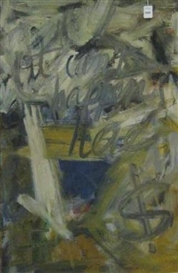
Dimensions: 36 x 23 1/2 inches
Medium: oil on canvas
Creation Date: 1956
KOFSKY: Who played the piano solo on ["It Can't Happen Here"]?
ZAPPA: I did.
KOFSKY: That's what I thought. Hence, "If you want to become a piano
player, go out and buy a Cecil Taylor record." [As Zappa stated in Hit
Parader.]
ZAPPA: That whole Freak Out! album is to be accessible as possible
to the people who wanted to take the time to make it accessible. That list of
names in there, if anybody were to research it, it would probably help them
a great deal.
You just cook a tv dinner
A frozen meal in an aluminum foil tray divided into compartments (one for the cardboard-flavored meat with gravy—this is always the largest compartment and is at the front of the tray—one for the pasty mashed potatoes, one for the peas and carrots that no one eats, and one for the disappointing little dessert).
FZ: Suzy, you just got to town, and we've been . . . we've been very interested in your development.
Perceived Instrumentation vs. Different Mixes
| |
Left |
Center |
Right |
| 1966 stereo mix (MOFO; MOFO fazedooh); 1969 remix (Mothermania); 1970 remix (MOFO fazedooh, CD 2, track 13); 1985/1987 remix (1985 LP; 1995 CD; 2012 CD; Understanding America) |
Voice #4—FZ |
Voice #1—FZ
Voice #2 (mmm)—
Voice #3 (girl)— |
Voice #5—FZ |
| 1966 stereo mix (MOFO; MOFO fazedooh); 1970 remix (MOFO fazedooh, CD 2, track 13); 1985/1987 remix (1985 LP; 1995 CD; 2012 CD) |
Drums #1— |
Piano—FZ |
Drums #2— |
Edits
| |
Freak Out! (2012 CD) |
single |
Mothermania (1969) |
1970 remix (MOFO fazedooh) |
Understanding America (2012) |
"Porn Wars Deluxe" (UA) |
| "It can't happen here..." |
0:00-1:05 |
0:00-1:05 |
0:00-1:06 |
0:00-1:06 |
0:00-1:06 |
05:02-06:08 |
| "Who could imagine..." |
1:05-1:08 |
1:05-1:08 |
1:06-1:09 |
1:06-1:08 |
|
|
| strings |
1:08-1:13 |
1:08-1:13 |
|
1:08-1:13 |
|
|
| piano & drums |
1:13-1:54 |
|
|
1:13-1:54 |
|
|
| "Who could imagine..." |
1:54-1:58 |
1:13-1:18 |
|
1:54-1:59 |
1:06-1:10 |
06:08-06:12 |
| "That they will freak out..." |
1:58-2:02 |
1:18-1:21 |
1:09-1:13 |
1:59-2:02 |
1:10-1:14 |
06:12-06:16 |
| "AC/DC..." |
2:02-3:28 |
1:21-2:47 |
1:13-2:40 |
2:02-3:28 |
1:14-2:40 |
|
| "Psychedelic" |
|
|
2:40-2:42 |
3:28-3:30 |
|
|
| "It's a real thing..." |
3:28-3:42 |
2:47-3:01 |
2:42-2:56 |
3:30-3:44 |
2:40-2:54 |
|
| "Since you first took the shots..." |
|
|
2:56-2:58 |
3:44-3:46 |
|
|
| "Forget it..." |
3:42-3:48 |
3:01-3:08 |
2:58-3:04 |
3:46-3:52 |
2:54-3:00 |
|
| ("...can't happen here, can't happen here...") |
|
|
3:04-3:08 |
|
|
|
| "...can't happen here..." |
3:48-3:55 |
3:08-3:14 |
3:08-3:18 |
3:52-3:55 |
3:00-3:06 |
|
15. The Return Of The Son Of Monster Magnet
Liner notes by FZ, 1966
THE RETURN OF THE SON OF MONSTER MAGNET . . . (12:17)—(Unfinished Ballet In Two Tableaux) I. Ritual Dance Of The Child-Killer. II. Nullis Pretii (No Commercial Potential), is what freaks sound like when you turn them loose in a recording studio at one o'clock in the morning on $500 worth of rented percussion equipment. A bright snappy number. Hotcha!
I think [Freak Out!] was the very first rock and roll double album. And it's not finished either. They released it before all the tracks were done on "Monster Magnet". That's just the basic track from "Monster Magnet". They wouldn't let me finish it. They said no one could spend any more money and that was it.
Monster Magnet
Back in around 1964/65, my brothers and I had a Monster Magnet. It was shaped like a big horseshoe magnet and was made out of red plastic. The handle was the monster's mouth and the arms of the magnet were it's big, muscular arms that ended in closed fists. In the fists—sort of like brass knuckles—were the actual magnets that seemed pretty strong for a kids' toy. I remember you could pick up a 5 gallon tin of potato chips with the thing.
The Recording Session
As the sessions continued, the more enthusiastic [Tom] Wilson became. About the middle of the week I told him, "I would like to rent five hundred [1965] dollars' worth of percussion equipment for a session that starts at midnight on Friday, and I want to bring all the freaks from Sunset Boulevard into the studio to do something special." He agreed.
We got the equipment and the freaks and, starting at midnight, recorded what turned out to be side four of the album. Wilson was on acid that night. I didn't know he had taken it—he told me later. I've tried to imagine what he must have been thinking, sitting in that control room, listening to all that weird shit coming out of the speakers, and being responsible for telling the engineer, Ami Hadani (who was not on acid), what to do.
I remember the third night of the recording mainly because the girls gave Tom Wilson some Acid. Frank didn't know how he would handle "Help, I'm A Rock" and the other things we did that night. The last session didn't actually start until about one o'clock in the morning. "Return of the Son of Monster Magner" was created in the studio. It was just a jam and, of course, the "Who Could Imagine" section was all done in the studio.
Dr. John
Dr. John played piano on quite a few things on the album, although he wasn't credited. I never thought that was very cool.
That's when we recorded sides three and four. Mac Rebannac, who later became Dr. John, played keyboards on the album although he didn't get credited on the sleeve; Paul Butterfield came down and played with us; Kim Fowley sang "Help I'm A rock"—it was a fun trip.
Dr. John (Mac Rebennack) with Jack Rummel, Under A Hoodoo Moon—The Life Of The Night Tripper, 1994, p. 128
Anyway, I did a couple of sessions for him, though, everybody in the studio but Frank was wandering around high on acid. Frank had written me this part to play, five or six notes on the piano over and over—not much different than Sonny and Cher. In the background, a twenty-voice choir croaked out monster sound effects, something like "Gggrrrrrrhhhhrrr!" When I had had about all I could take, Les McCann walked in and I asked him to hold down my chair, telling him I had to go to the bathroom. I walked out of there and never came back.
Cal Schenkel
In 1966 [Calvin Schenkel] was a nineteen-year-old kid hitch-hiking in LA when a jeep full of girls picked him up and dropped him at a rock'n'roll recording session. The rock bandleader was Frank Zappa and the record was his debut: Freak Out! by The Mothers of Invention. The two men met in passing but wouldn't see each other again for another year.
Calvin Schenkel, Cal Schenkel Magazine, September, 1981
1966-(February, I think)
I am hitch-hiking down Sunset one night, when a carload of Hollywood crazies stops and I jump in. They tell me they are on their way to a "session"—why don't I join them? I have no idea what they're talking about until we arrive at TTG Recording Studio. We're directed into a room with about 100 people dancing and pounding on kettle drums and screaming "Help I'm A Rock!" Leading this madness is a strange looking fellow that I see all the time at Canter's. Little did I know that a year and a half later I would be working for this man.
Pamela Zarubica and others
'They drove us to the TTG Studios on the corner of Sunset and Highland. It wasn't long before the studio began to fill up with people, all the freaks, and Mark Cheka—who always scared me . . . he looked like a werewolf—who was past manager of The Mothers. And there was Billy James [and his] wife named Judy . . . Tommy Flanders was there with his troll Maxine, sure ones to make any event . . . The Mothers played and the freaks danced and sang. Kim Fowley was up front doing his monologue, and Carl and Vito were screaming in the background.'
Howard Kaylan
Howard Kaylan, interviewed by Cody Conard, Neotomic Aliviac, April 9, 2009
We had both known Frank for many years, both in LA and subsequently when Frank took the Mothers into NYC for a year at the Garrick Theater in the Village. We hung out with them there. I actually did some voices late one night in an LA studio that wound up on the Freak Out album where Frank quotes a noted LA disc jockey as saying, "Let me clean you boys up a bit and make you as big as the Turtles."
Cherry Wood
Charles Ulrich, October 6, 2014
Cherry [Wood] played spoons on Freak Out!
Other People
I first saw Frank Zappa last winter when David Anderle, music world "court painter" and also manager of Danny Hutton, called to invite me to a Freak Out recording session. The studio was opened at 1 a.m. on a Friday, and it was soon filled with a couple of hundred kids from the Sunset Strip, the Mothers of Invention, "chorus leader" Kim Fowley, and various guests like Paul Butterfield and Les McCann. It went on for hours and everybody participated—some singing, some moaning, others popping gum into speakers—I don't think there has ever been anything like it!
Guests included Paul Butterfield, Les McCann, Danny Hutton (later of Three Dog Night) and four cast members from The Untouchables TV series.
Suzy Creamcheese
FZ: Suzy Creamcheese, honey, what's got into ya?
C: Who was the original "Susie Creamcheese"?
Z: The original girl's name was Jeanne Vassoir.
C: Was it just something that was adopted into the show? Who approached who?
Z: It was something I made up, and then she became "Susie Creamcheese".
Suzy Creamcheese was a girl named Jeanne Vassoir. And she is the voice that's on the Freak Out album. The myth of Suzy Creamcheese, the letter on the album, I wrote myself. There never really was a Suzy Creamcheese. It was just a figment of my imagination until people started identifying with it heavily. It got to weird proportions in Europe, so that in 1967, when we did our first tour of Europe, people were asking if Suzy Creamcheese was along with us. So I procured the services of another girl named Pamela Zarubica, who was hired to be the Suzy Creamcheese of the European tour. And then she maintained the reputation of being Suzy Creamcheese after 1967. The first one went someplace, we don't know where. She's back in town now; I saw her.
Charles Ulrich, October 6, 2014
According to Jean's ex-husband, her surname was Vassar.
Captain Beefheart, Oui Magazine, July, 1973
Years ago, I was taped by Frank Zappa, and a lot of ideas on a lot of his records started out with me. Like Susie Cream Cheese, What's Got into You?, and Brown Shoes Don't Make It.
I don't know if this is well known, but Suzy Creamcheese existed before "Freak Out!" In reading Roger Ebert's "Big Book of Film" I came across an article by John Updike from his days as a film critic. In the article, a tribute to Doris Day, she mentions that friends have taken to calling her "Suzie Creamcheese." I was shocked, but perhaps others know about the history of the nickname better than I.
Charles Ulrich, November 26, 2015
That Updike article was published in 1983, and he was quoting Doris Day's autobiography, which was published in 1975. So this doesn't prove that the name "Suzy Creamcheese" was around before Freak Out!
"Susie Creamcheese" was a popular name for plain, ordinary, non-freaky American girls since I was a kid in the early '60s. (And probably earlier). I'm sure FZ saw the potential for parody there.
Parts
| Freak Out! (2012 CD) |
Instrumentation |
Notes |
| I. Ritual Dance Of The Child-Killer |
| 00:00-00:15 |
FZ—voice
Jean Vassar—voice |
|
| 00:15-08:09 |
Drums—JCB
Electronic sounds
Prepared piano
Lion's Roar
Voices |
05:22-06:04; 06:34-07:16; 7:30-7:50 (sped-up 12 semi-tones) include voices from "Help, I'm A Rock" (4:00-4:43); 00:18-08:07 basic track on "Cream Cheese (Work Part)" (MOFO) (0:00-7:54); at 04:02-04:06 the siren and roar from 00:15 are heard again. |
| 08:09-08:22 |
Voices |
|
| II. Nullis Pretii (No Commercial Potential) |
| 08:22-08:58 |
Voices
Prepared piano |
sped-up 12 semi-tones, voices from "Help, I'm A Rock" (4:00-4:43) |
| 08:58-10:14 |
Voices
Timpani
Prepared piano |
09:32-10:14, voices from "Help, I'm A Rock" (4:00-4:43) |
| 10:14-10:54 |
Voices
Piano
Spoons |
|
| 10:54-11:05 |
Voices |
reversed |
| 11:05-11:10 |
Voices |
|
| 11:10-11:24 |
Voices
Piano
Spoons |
sped-up 12 semi-tones; 11:11-11:24 appears at original speed on "Hold On To Your Small Tiny Horses . . . " (MOFO) (0:00-0:26) |
| 11:24-11:25 |
Voice |
"Hold On To Your Small Tiny Horses . . . " (MOFO) (0:26-0:27) |
| 11:25-12:16 |
Voices
Piano
Spoons |
sped-up 12 semi-tones; appears at original speed on "Hold On To Your Small Tiny Horsies . . . " (MOFO) (0:27-2:08) |
Perceived Instrumentation vs. Different Mixes
| |
Left |
Center |
Right |
| "Cream Cheese (Work Part)" (MOFO, CD 4, track 4) |
Prepared piano—
Voice #1—Ray Collins?
Lion's roar—
Voice #2 ("Oh baby")— |
Drums—JCB
Timpani—
Tambourine—Ray Collins
Congas— |
Freak voices #1 (objects)—Kim Fowley & Freaks
Harmonica— |
| "Hold On To Your Small Tiny Horsies . . . " (MOFO, CD 2, track 19) |
Voice #6 ("Did you pick up on that?")— |
Voice #3 (girl)—Jean Vassar
Voice #4—
Spoons—
Voice #7 (girl)— |
Prepared piano—
Voice #5 ("Fuck!")—FZ |
| 1966 stereo mix (MOFO; MOFO fazedooh) |
Voice of the conscience ("Suzy?")—FZ
Suzy Creamcheese ("Yes")—Jean Vassar
Electronic effects—
Freak voices #2—
Voice #9 (foreign voice)—
Pre-recorded "monkey" voices—
Voice #10 (#3) (girl) ("Oh wow")—Jean Vassar?
Voice #11 (#4) (foreign voice)—
Spoons—
Voice #6 ("Did you pick up on that?")—
|
Drums—JCB
Timpani—
Tambourine—Ray Collins
Congas—
Freak voices #1 (objects)—Kim Fowley & Freaks
Siren—
Voice #8 (freak)—
Voice #12 ("It's happening, man")—
Pre-recorded "monkey" voices— |
Prepared piano—
Voice #1—Ray Collins?
Lion's roar—
Voice #2 ("Oh baby")— |
| 1985/1987 remix (1985 LP; 1995 CD; 2012 CD) |
Siren—
Voice #8 (freak)—
Electronic effects—
Freak voices #2—
Voice #9 (foreign voice)—
Pre-recorded "monkey" voices—
|
Voice of the conscience ("Suzy?")—FZ
Suzy Creamcheese ("Yes")—Jean Vassar
Drums—JCB
Timpani—
Freak voices #1 (objects)—Kim Fowley & Freaks
Tambourine—Ray Collins
Congas—
Voice #10 (#3) (girl) ("Oh wow")—Jean Vassar?
Voice #11 (#4) (foreign voice)—
Voice #12 ("It's happening, man")—
Spoons—
Voice #6 ("Did you pick up on that?")—
|
Prepared piano—
Voice #1—Ray Collins?
Lion's roar—
Voice #2 ("Oh baby")— |

